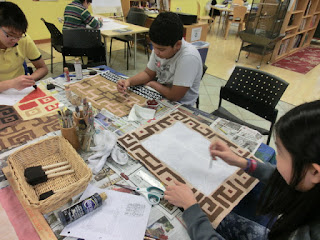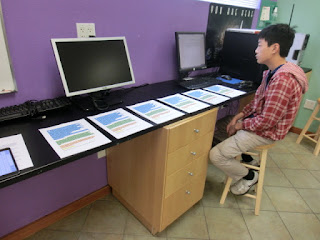We do our best to focus while we observe the lesson and prepare to work together.
Suzuki sensei can tell we are almost too excited to wait for class to begin!
Brandon sensei loves it when we play and learn at the same time.
 |
| タレ用にごまをすっています。 I'm grinding sesame for a dipping sauce. |
 |
| ボランティアの方たちがもち米を臼に入れてくださいます。 Parent volunteers are dumping the mochi rice into Usu (mortar). |
 |
 |
| ICからECまで、各学年の子供たちが餅をつきました。 Children of all the levels enjoyed pounding mochi. |
 |
| つけた餅は小さく丸く丸めます。 We are rolling the mochi into small balls. |
 |
| 手作りのたれをかけます。 I'm pouring the sauce we made onto the mochi. |
 |
| おいしい! |
 |
| First the students were required to plan their approach using a miniature sketch of their project. |
 |
| Repeating blocks of patterns are a key feature of Kuba. Collectively, when paired in contrasting patterns, the effects can be striking. |
 |
| Although the traditional palette for Kuba is based on earth and neutral tones, color can feature too! |
 |
| Some students opted for borders; others for large blocks of contrasting shapes and colors. |
 |
| We also worked on our regular lessons during this big project. Here our Chinese students are practicing English verbs. |
 |
| We found that the hardest part was getting started. White textile is not forgiving of mistakes! |
 |
| The overall effects came together quickly once we started putting color on our textile. |
 |
| And - we continue to work on Spring Festival. Here we are collating scripts so people can start learning their parts! |
 |
| Working on the Chinese vignette script based on a folk tale with some expert help from our two Chinese students! |
 |
| Two students are working simultaneously on a vignette featuring an Ancient Egyptian legend |
 |
| Working on getting materials ready for our West African cultural project |
 |
| Art table is ready for some exciting work which will be displayed in the EC hallway soon! |